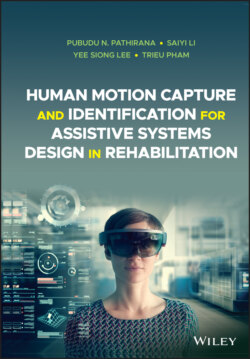Читать книгу Human Motion Capture and Identification for Assistive Systems Design in Rehabilitation - Pubudu N. Pathirana - Страница 9
1
Introduction 1.1 Human Body – Kinematic Perspective
ОглавлениеThe human musculoskeletal system (also known as the locomotor system) is the combination of two main components, namely a passive skeletal system and an active muscular system to facilitate human movements with support and stability. The skeletal system initiates with 230 bones at birth and reduces to 206 due to fusion of some bones as the person reaches adulthood and these bones form the axial skeleton and the appendicular skeleton via 360 joints. There are four types of bones in the human body, namely short bones, flat bones, irregular bones and sesamoid bones, while there are three types of joints, immovable joints, slightly movable joints and freely movable joints. The muscular system includes muscles, tendons, ligaments, and other connecting tissues [108]. Figure 1.1 is a depiction of these two components.
The muscular system consists of over 700 muscles, which can be classified mainly into skeletal, cardiac and smooth muscles. Facial and tongue muscles are special cases with the tongue having the largest concentration of muscles. Based on the functionality, the muscles can also be classified as involuntary (cardiac, smooth) and voluntary (skeletal).
Human body kinematic movements can be classified into two main types – voluntary and involuntary. Execution of daily activities and specialised activities with complete cognitive control causes voluntary movements and such movement is the expression of a thought through action. Almost all areas of the central nervous system are involved in the execution of voluntary movements and the main flow of information may begin in cognitive cortical areas in the frontal lobe or in sensory cortical areas in the occipital, parietal and temporal lobes. Ultimately, information flows from motor areas in the frontal lobe through the brain stem and spinal cord to the motor neurones [110].
Muscles are contracted due to the signals received throughout the central nervous system. The peripheral nervous system that is associated with the skeletal muscle voluntary control of the body is referred to as the somatic nervous system. There are 43 segments of nerves in the human body and associated with each segment is a pair of sensory and motor nerves. The spinal cord has 31 segments of nerves while the remaining 12 are in the brain stem. The electrical signals instigated from the brain are transmitted through the nerves and prompt the release of the chemical acetylcholine from the presynaptic terminals. This chemical is picked up by special sensors (receptors) in the muscle tissue. If enough receptors are stimulated by acetylcholine, the muscles will contract and force the specific part of the body to move. Almost all voluntary motor functions are controlled by the area referred to as the motor cortex in the brain. The primary motor cortex generates neural impulses to activate the muscle contractions and the nerves cross the body midline so that the left hemisphere of the brain controls the right side of the body and vice versa. Other areas of the motor cortex include the posterior parietal cortex, the premotor cortex and the supplementary motor cortex. The posterior parietal cortex is involved in transforming visual information into motor commands and transmits the information to the premotor cortex and the supplementary motor cortex. The supplementary motor cortex is involved in planning complex motions and also coordinating the two hands, whereas the premotor cortex is invoked in sensory guidance of movement and controls the more proximal muscles and trunk muscles of the body. According to Taga [345], the neural system indeed formulates structured sequences of signals or can even be considered as programs for the human motion via activation of muscles. Therefore, certain physiological conditions or injuries that affect the primary motor cortex (Figure 1.2) can adversely affect the functionality of the locomotor system.
Figure 1.1 The demonstration of the passive and active locomotor system. Sources: (a) https://commons.wikimedia.org/wiki/File:Human_skeleton_front_en.svg; (b) https://commons.wikimedia.org/wiki/File:1105_Anterior_and_Posterior_Views_of_Muscles.jpg.
Figure 1.2 Functional description of the brain motor cortex.
